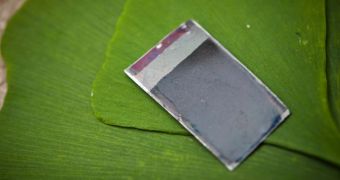A group of scientists at the Massachusetts Institute of Technology (MIT), in Cambridge, announce the development of an “artificial leaf,” a device capable of harnessing solar energy in very much the same way, and with similar levels of performance, as a natural leaf.
The new system's natural counterpart had millions of years of evolutionary advantages over its synthetic competitor, but it could not last long when faced with the determination of MIT researchers.
Unlike solar cells – which convert photons into electrons – the new system works by converting sunlight directly into a chemical fuel, just like plants do. This mixture can then be preserved, and used whenever it's needed.
Primarily, the artificial leaf comprises an innovative, silicon-based solar cell that is augmented with a large variety of catalytic materials on either side. Externally, there are no wires or electronic control circuits attached to the tool.
MIT scientists thought of an ingenious use for it – the artificial leaf generates oxygen bubbles of hydrogen from one face and bubbles of hydrogen from the other, after submerged in water. All that is needed for the system to work is for the container holding the water to be exposed to sunlight.
One potential application for such a capability is to place the device inside a membrane that separate two distinct bodies of water. Bubbles coming out of each side of the device could be collected separately, providing a cheap source of both oxygen and hydrogen.
Once this is achieved, the two chemicals can be used separately, or they can be inserted in separate compartments inside a fuel cell, and put back together to form water and electricity. One could image such a cycle going on for a long time inside a vehicle, without the need to recharge.
Details of the new investigation were published in the September 30 issue of the top journal Science. The study team was led by Daniel Nocera, who is the MIT Henry Dreyfus professor of energy and professor of chemistry. He is also the the senior author of the paper.
The team leader reports that the artificial leaf is made of inexpensive materials that can be easily found, such as silicon, cobalt and nickel. “I think there’s going to be real opportunities for this idea,” he says.
““You can’t get more portable – you don’t need wires, it’s lightweight. You just drop it in a glass of water, and it starts splitting it,” Nocera adds. The process of splitting water into hydrogen and oxygen is called electrolysis.
All that is needed in addition to water, sunlight and this device is a means of capturing the bubbles.

 14 DAY TRIAL //
14 DAY TRIAL //